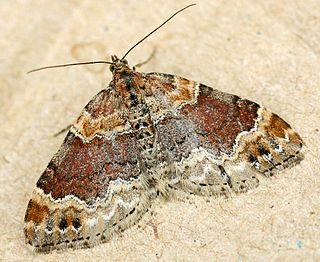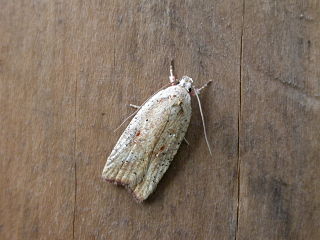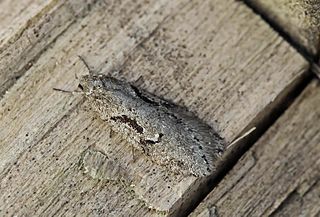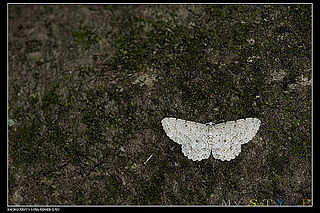
The sycamore is a moth of the family Noctuidae. The species was first described by Carl Linnaeus in his 1758 10th edition of Systema Naturae. It is distributed through most of Europe, from central England south to Morocco. To the east it is found from the Near East and Middle East to western Asia.

Xanthorhoe spadicearia, the red twin-spot carpet, is a moth of the genus Xanthorhoe in the family Geometridae. The species was first described by Michael Denis and Ignaz Schiffermüller in 1775.

Catocala fraxini, the blue underwing or Clifden nonpareil, is a moth of the family Erebidae. The species was first described by Carl Linnaeus in his 1758 10th edition of Systema Naturae.

Hoplodrina blanda is a moth of the family Noctuidae. It is found in the Palearctic realm.

Erebus macrops, the common owl-moth, is a species of moth of the family Erebidae first described by Carl Linnaeus in 1768. It is found in the subtropical regions of Africa and Asia. The wingspan is about 12 cm, making it exceptionally large for an Erebidae species. The larvae feed on Acacia and Entada species.

Scoparia subfusca is a species of moth of the family Crambidae. It is found in Europe.

Diacrisia sannio, the clouded buff, is a moth of the family Erebidae. The species was first described by Carl Linnaeus in his 1758 10th edition of Systema Naturae.

Phragmatobia fuliginosa, the ruby tiger, is a moth of the family Erebidae.

Euxoa obelisca, the square-spot dart, is a moth of the family Noctuidae. It is found in the Palearctic realm.

Gracillaria syringella is a moth of the family Gracillariidae. It is found in Europe. It has been introduced in North America.

Chortodes fluxa, the mere wainscot, is a moth of the family Noctuidae. The species was first described by Jacob Hübner in 1809. It is found in Europe and east across the Palearctic to Siberia, Mongolia, and northern China. Also in northern Turkey and the Caucasus.

The gorse tip moth is a smallish moth species of the family Depressariidae.

Lygephila craccae, the scarce blackneck, is a moth of the family Erebidae. It is found in temperate Europe and across the Palearctic to the Altai Mountains, Korea, Japan and China.

Urapteroides astheniata is a moth of the family Uraniidae first described by Achille Guenée in 1857. It is found in south-east Asia, from India, Sri Lanka to Fiji, including New Guinea and the tropical north of Australia.

Caloptilia populetorum is a moth of the family Gracillariidae. It is found in most of Europe, except Italy, the Balkan Peninsula and the Mediterranean islands.

Heterocrossa gonosemana is a species of moth in the family Carposinidae. It is endemic to New Zealand and is found throughout the country. It inhabits native forest. Larvae feed on seeds and fruit of Griselinia lucida and possibly Griselinia littoralis. They can be extremely active when disturbed. This species overwinters as a pupa, enclosed in a cocoon, underneath its host plant. Adults are on the wing from November until February and can be found during the day resting on lichen covered tree trunks where they are well camouflaged. The adult is nocturnal and is attracted to light.

Semioscopis steinkellneriana is a species of moth of the family Depressariidae. It is found from most of Europe east to the eastern parts of the Palearctic realm.

Spilosoma sumatrana is a moth of the family Erebidae. It was described by Charles Swinhoe in 1905. It is found on Sumatra, Java and in Malaysia.

Catoria sublavaria is a moth of the family Geometridae described by Achille Guenée in 1857. It is found in the tropics of India, Sri Lanka, Myanmar, towards New Guinea, to the Bismarck Islands and Taiwan.
Protolychnis maculata is a moth in the family Lecithoceridae. It was described by Thomas de Grey, 6th Baron Walsingham, in 1881. It is found in the Democratic Republic of Congo (Orientale), Namibia, South Africa, Tanzania and Zimbabwe.

















